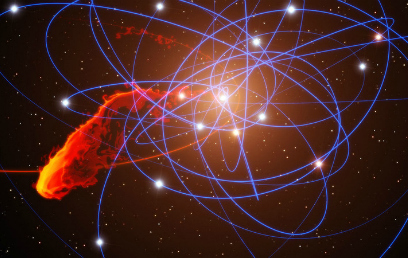Doomed Blob of Gas Headed for Black Hole
Astronomers will get to watch a black hole devour material for the first time, as a gas cloud barrels toward the center of the Milky Way
Not long from now, astronomers are going to witness something they’ve never seen before: a black hole chowing down on a feast. Although scientists have a short list of probable black holes, there’s only one close enough for us to observe with any detail, and that’s the one in the center of the Milky Way, Sagittarius A*, or Sgr A*. Scientists at the Max Planck Institute for Extraterrestrial Physics confirmed this week in Nature that they’ve discovered a gas cloud plowing straight for it.
Sgr A* is a “supermassive” black hole, with the mass of about four million Suns. Although these still mysterious objects are difficult to observe directly, since they absorb all light that gets too close, there are a few ways to gather data. One is by studying the accretion disk; the extreme gravitational forces coming from the black hole compress material as it falls ever closer, and this causes an emission of electromagnetic radiation. With black holes, that radiation is usually in the x-ray range. Studying this radiation can tell astronomers a lot about the black hole itself.
So why is the discovery of this gas cloud so exciting? Because Sgr A* is a fairly quiet black hole. There’s not a lot of nearby material for it to feast on, and so not a lot of data for astronomers to collect. But this gas cloud is barreling down a path almost straight toward Sgr A*. Using the European Southern Observatory’s Very Large Telescope in Chile’s Atacama desert, the astronomers have been able to track the cloud’s path and determine its size and mass — it covers an area about the size of our solar system, with the mass of just three Earths.
Even more exciting, in a universe where human life spans are mere blips in astronomical time, it turns out this gas cloud is going to reach Sgr A* in just about 18 months. The same Max Planck scientists who authored the Nature paper will be the ones collecting data from the VLT in mid-2013. That has to be high on the list of astronomer dreams.
The cloud is already close enough to start being stretched apart by gravitational forces, which are pulling it toward the black hole faster and faster — the speed of the cloud has doubled in the last seven years, and it is now moving over 5 million miles per hour. In this short film, astronomer Stefan Gillessen says the cloud “will be elongated and stretched, it will become essentially like spaghetti, and… fall into the black hole.” Or, as one of the best lines we’ve read in a science article in a long time puts it, “The inevitable doom of such a blob of gas is its inexorable tendency towards fragmentation.”
